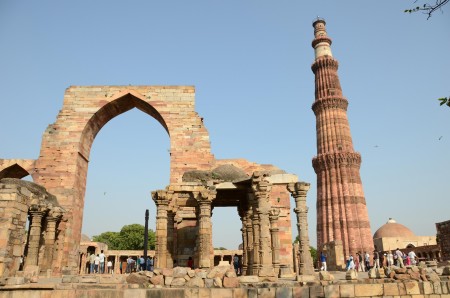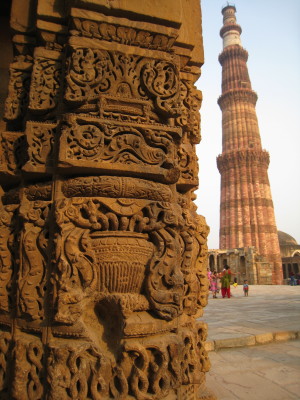Qutub Minar The Tallest Construction
Qutub Minar The Tallest Construction:

Qutub Minar is one of the world’s tallest construction and a World Heritage site in Delhi. It is situated in the heart of Delhi and is ruled under
Thomas Rajpoots and Chauhans in the early 11th Century. Later in 1060 AD Muhammad Ghori defeated Prithvi Raj Chauhan, and Delhi came under the rule of Qutbuddin Aibak, the Governor of Muhammad Ghori.
Are Hindus Constructed the Qutub Minar?:
Qutub Minar was a Hindu tower that had existed hundreds of years before Kutubuddin. In the early days, Kutub Minar was known as Mehrauli. Mehrauli is a Sanskrit word, and Mihira is a well-known astronomer who used the Kutub tower as an observation post for astronomical study. In those days, the Mehrauli complex had 27 Hindu temple pavilions around the Mehrauli tower.
Qutub Minar Renovation works During Muslim Rulers:
Kutubuddin destroyed all these pavilions, ravaged the temple, and renamed Kuwait-ul-Islam mosque. The Invaders used to remove the stone of the Hindu temples and turn the stones inside to hide the Hindu God images facial and inscribe Arabic lettering on the new frontage. Some rocks have Hindu images and Arabic scriptures that have been removed from the Museum. Some of the sculptures were destroyed, and others were disfigured.
The tower and the surrounding structures were constructed in the style of Hindu buildings; its ornate style proves that it is a Hindu tower. And also, the outlook is not in the plan of Mosque minarets. The tower was meant to call the Muslim residents to pray, so they would have found that no one on the ground could hear them from that height.
Unique of the Towers:
The tower faces north, but the Islamic theology of the prayer conducted keeps the devotee’s faces towards the West. The entrance of the building is carved lotus flower emblem in granite stone, which proves the building belongs to Hindu tradition. The lotus flowers are very sacred symbols to the Hindus.
The tower had seven storeys representing we, representing only five storeys existing. The sixth was dismantled, and the seventh storey had placed the statue of four-faced Brahma holding the Vedas. Vishnu temple is also very near the bottom of the tower; Muslim raiders also demolished this one.
Qutub Minar as Hindu Temple:

According to Modern History, in 1198 AD, Qutub-ud-din-Aibak built the Qubbat-ul-Islam mosque to the northeast of the present Qutub Minar. The reason behind the Qutub Minar is not known perfectly, but around 1202, Aibak constructed the Qutub Minar. Some think that it was built as the victory tower. At the same time, others believe it is just a minaret to the adjacent mosque, and others feel that the building calls the faithful to prayer. The inscription on the central-eastern gate of the monument indicated the Jain and Hindu stories. Another Sanskrit on one of the walls of the Qutub complex mentions that Qutub Minar was called Vishnupada and was constructed around the 4th Century A.D.
Qutub Minar Construction:
It is the highest stone tower in India, with 72.5 m in height and 379 stairs. Qutub-ud-din built the first storey around 1202; his successors made the remaining storeys. Iltutmish, the son-in-law of Qutubuddin, built the two circular storeys in white marble. Firozshah Tughlaq completed the entire tower with marble in 1368 AD.
Qutub Minar As a Tourist Place:
Qutub Minar has been renovated occasionally due to the suffering of various earthquakes and other lightning strikes. The Minar bend is just 25 cm from which even though it is safe. In 1981, the public was allowed into the monument. On 4 December 1981, a power cut in the tower led to a stampede in which 45 people died, so people were not allowed inside the Minar now.
Other tourist spots around Qutub Minar:
There are many tourist places around Qutub Minar: the Ansal Plaza, Qila Rai Pithora, Red Fort, Moth Ki Masjid, Garden of Five senses, Alai Darwaza, Alai Minar, Bahai Lotus Temple, Sanskrit Museum, INA Market. There is also a considerable Golf Course.